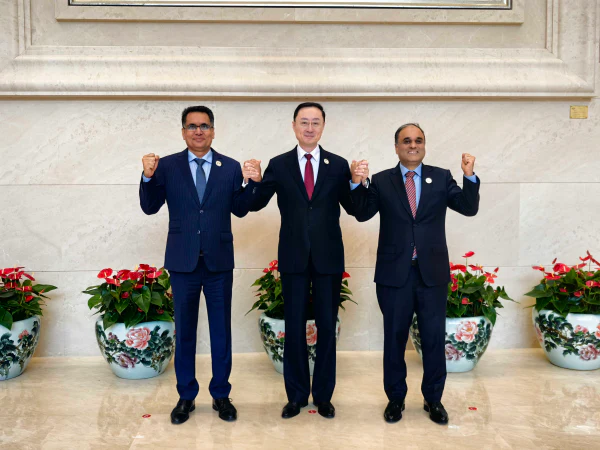Pakistan and China are actively preparing the ground for a new regional grouping, aiming to fill the vacuum left by the South Asian Association for Regional Cooperation (SAARC), which has remained inactive for nearly a decade. Recent diplomatic activity, including high-level meetings in China, signals a determined push by both countries to create an alternative platform for South Asian cooperation, with Bangladesh already participating in the early discussions.
What is SAARC?
The South Asian Association for Regional Cooperation, or SAARC, was established in 1985 to promote economic, cultural, and regional integration among South Asian countries. Its founding members are India, Pakistan, Bangladesh, Bhutan, Nepal, Sri Lanka, and the Maldives, with Afghanistan joining later. The group was created to encourage collaboration in trade, education, health, and security, and to build trust among member nations.
However, SAARC’s progress has long been hampered by political tensions, especially between India and Pakistan. The last major blow came in 2016, when the planned summit in Islamabad was cancelled after India withdrew in response to the Uri terror attack. Bangladesh, Bhutan, and Afghanistan soon followed suit, leaving SAARC unable to hold any high-level meetings or summits since then. This paralysis has left the region without a functioning platform for dialogue and cooperation, and efforts to revive SAARC have not succeeded so far.
China and Pakistan’s New Initiative
In the absence of SAARC, Pakistan and China have intensified efforts to build a new regional alliance. The process gained momentum in recent months, with China hosting two significant trilateral meetings in Kunming. The first meeting brought together China, Pakistan, and Afghanistan, while the second included China, Pakistan, and Bangladesh. India was excluded from both gatherings.
These talks focused on expanding trade, improving connectivity, and enhancing security cooperation. China has proposed that this new grouping should also include other South Asian countries such as Sri Lanka, the Maldives, and Afghanistan. The main goal is to foster regional integration and economic development, areas where China’s Belt and Road Initiative (BRI) already plays a leading role. Sources say China is pushing for the creation of a multi-sectoral working group to formalise this emerging bloc and to address issues ranging from infrastructure to counter-terrorism.
Bangladesh’s participation in the Kunming meetings has drawn particular attention. While Dhaka’s interim government has downplayed the political significance of these talks, stating that no formal alliance is being formed yet, the diplomatic activity has raised concerns in New Delhi. Observers note that Bangladesh’s engagement with China and Pakistan comes at a time when ties between Dhaka and New Delhi have faced some strain, and China is looking to strengthen its presence in the region.
Pakistan, for its part, has been keen to create a new platform ever since SAARC became inactive. Islamabad has argued that SAARC’s failure to function is due to India’s reluctance to engage, and it sees the new initiative as a way to revive regional cooperation without Indian participation. Pakistani officials have also indicated that the new grouping will be open to all former SAARC members, including India, but they do not expect New Delhi to join.
What does this mean for India?
For India, these developments represent a significant strategic challenge. India has traditionally been the dominant player in South Asia and a key driver of SAARC. The new initiative led by Pakistan and China is widely viewed as an attempt to counterbalance India’s influence and to give China a greater foothold in the region. Indian officials have expressed concern over the growing closeness between Bangladesh and China, especially as Beijing facilitates dialogue between Dhaka and Islamabad.
The exclusion of India from the Kunming meetings is seen as a deliberate move to reshape regional alignments. China’s active role in these talks is part of its broader strategy to expand its influence in India’s neighbourhood, using economic incentives and infrastructure projects to draw countries closer. For India, the emergence of a new bloc could complicate its efforts to maintain regional leadership, especially if neighbours like Bangladesh, Sri Lanka, and the Maldives become more closely tied to China and Pakistan.
At the same time, India’s absence from the new grouping is likely to limit the bloc’s ability to address the region’s most pressing challenges, given India’s size, economy, and strategic importance. Indian policymakers are watching developments closely, aware that any new alignment could have far-reaching implications for the country’s security, trade, and diplomatic interests.
The Road Ahead
As talks continue, it remains to be seen whether Pakistan and China’s efforts will succeed in creating a viable alternative to SAARC. The inclusion of countries like Bangladesh, Sri Lanka, and the Maldives will be crucial for the new bloc’s credibility and effectiveness. While officials in Dhaka have downplayed the political nature of the Kunming meetings, the region is watching closely as China and Pakistan push forward with their plans.


